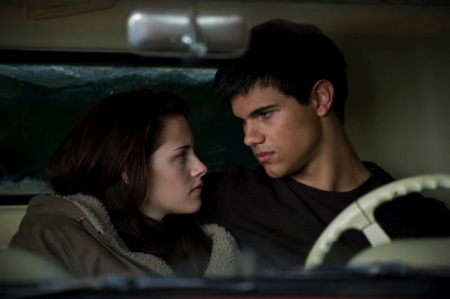“You’re good with weird,” a character tells Bella mid-way through “The Twilight Saga: New Moon.” That’s an understatement. In the first Twilight movie, as in the first of the series by Stephanie Meyer, high school student Bella Swan (Kristen Stewart) moved to the rainiest town in the US, Forks, Washington and fell deeply in love with Edward (Robert Pattinson), who looked like a teenager but was in fact a vampire who was more than 100 years old. He and his “family,” the Cullens, are sort of vampire vegetarians, living on animal blood. But there are other vampires who continue to prey on humans, and they almost killed Bella before Edward rescued her. And then they lived happily ever after until it was time for another book/movie, and that is where we begin.
Edward, convinced that their relationship will always put Bella in danger, leaves, telling her he will never see her again. She is devastated and isolates herself from everyone. She discovers that Edward appears to her when she is in danger, so she takes some foolish risks, just to feel close to him. But then the quiet support and gentle teasing of her friend Jacob (Taylor Lautner) begin to make her feel that she is able to be a part of the world again.
 Like Edward, Jacob loves Bella and would do anything to protect her. And like Edward, Jacob has a secret. He is part of a tribe of wolf-people. Like “The Hulk,” his anger manifests itself in a powerful transformation. And Bella finds herself at the center of a centuries-old war between the vampires and the wolves.
Like Edward, Jacob loves Bella and would do anything to protect her. And like Edward, Jacob has a secret. He is part of a tribe of wolf-people. Like “The Hulk,” his anger manifests itself in a powerful transformation. And Bella finds herself at the center of a centuries-old war between the vampires and the wolves.
The wildly popular Twilight Saga has the core elements of girl-friendly romances from “Wuthering Heights” to “Titanic:” a boyfriend who is not approved by parents who is utterly undone by the appeal of the female lead, and something to make sure that their relationship is about longing, not satisfaction. Just in case you aren’t paying close attention, we see Bella sleeping with a copy of “Romeo and Juliet” on her pillow, and her English class watching a video of the play. The teacher calls on Edward to recite one of Romeo’s speeches. And later, Edward, like Romeo, believes that his love is dead and decides he cannot live without her.
There is a lot of longing. Characters exchange meaningful looks and take an extra beat before responding to allow for some strategic intakes of breath and swelling of the score. There are moments that are more perfume commercial than movie. And as in the book, this big love Bella and Edward feel is expressed mostly in talking about the big love they feel. In a way, this is wise; we never see them doing or seeing anything that would interfere with our ability to project onto them whatever the specifics of our own fantasies of love look like. All we know or need to know is that Bella and Edward have the big, total, all-encompassing, would do anything for each other love. Just like Romeo and Juliet.
And we have Lautner’s excellent abs, which play such a significant role they should have their own billing. Lautner also has an easy confidence and sincerity on screen that nicely leavens the intensity and drama of the Bella-Edward connection. The screenplay is seasoned with some humor and a reference to self-referential cleverness that is almost meta.
New director Chris Weitz does not have Catherine Hardwicke’s feel for the rhythms of teenage interactions and the intensity of teen romance. And he does not have her ability to tell the story through the settings; we miss the lush natural world of the first chapter. Weitz and screenwriter Melissa Rosenberg also have to grapple with a transitional story that translates less well to screen than the first one. But the film benefits from his greater experience with special effects and a bigger budget. He catches the spirit of the story and allows the natural chemistry between his leads do the rest. And that is enough to make this movie enormously enjoyable and keep us looking forward to the next one.
(more…)


